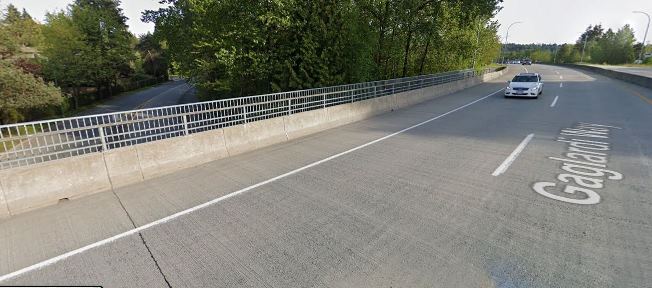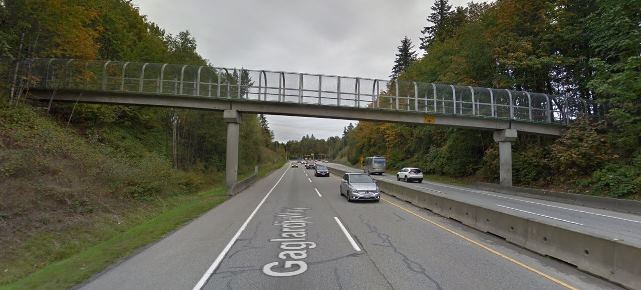I’m going to pick one specific part of the new pedestrian overpass on Stewardson that bugs me. I dropped by to look at the near-completed project (which, I hasten to note, was paid for by the Province and Feds, not the City), and have a bunch of negative feelings about it for a variety of reasons I mentioned here, and concerns I raised here, but it is this picture shows what currently bugs me the most:
Why the hell do pedestrians need to be kept in cages?
A quick Google Map tour of the overpasses rebuilt as part of the recently-expanded Highway 1 through Burnaby and Surrey provides these images of overpasses for cars that have sidewalks on them for pedestrians:





Now compare these to overpasses build specifically for pedestrians: 112th Ave.
112th Ave.

Notice the difference?
This isn’t limited to Highway 1, or even to Ministry of Transportation infrastructure. Go to your favourite road-overpass-with-a-sidewalk-over-another-road anywhere, and you see a normal elbow-to-shoulder height fence to keep pedestrians from falling off the edge:
Winston Street, Burnaby.

But look at any pedestrian-only-overpass, and you have the perimeter fence from San Quentin:
Winston Street, Burnaby.

Can anyone explain this to me? Presumably, this is to protect the underflowing traffic from nefarious activity of suspicious non-car-having people. But if that is so, why not also put a cage up at the overpass where non-car-having people are walking beside car-having people? Is simply the presence of car-having people enough to keep non-car-having people from doing nefarious activity? Is not having a car such a suspicious activity that even when non-having, being proximal to those who are currently having is enough to mitigate the suspicious activity so the cage isn’t necessary?
Of course, I don’t think is the actual thought process that creates this strange discrepancy, but I think it is a window in the cultural bias of transportation engineering. Building a pedestrian overpass? Need a cage to protect the drivers. Building a car overpass? Sure, we’ll throw a sidewalk on it (not like anyone is going to use it!). Pedestrians (and cyclists to a lesser extent) are accessories to transportation at best, impediments to efficient transportation at worst. They are something that needs to be accommodated as we decide the best way to move the real road users – cars and trucks – around in the City. Look around at how our transportation systems are built, even today, and you see this bias built in, even in the most walkable urban neighbourhoods like New Westminster.
It is this bias that decided spending $5.2 Million to get pedestrians out of the way was a better solution than spending a fraction of this to slow trucks and cars down to the posted speed limit to make Stewardson safe for pedestrians and cyclists. This expensive intervention is the exact opposite of Active Transportation infrastructure, because it gives up on the idea of slowing cars and trucks down to the posted speed limit before they get to the crosswalks at 5th Ave or 3rd Ave so those pedestrian spaces don’t feel so terrifying.
I hope, but am not confident, that the provincial Active Transportation Strategy will include a cultural shift in the Ministry of Transportation to one where active transportation will be found to be equal to, or even emphasized over, the dangerously rapid movement of cars and trucks. I also hope that the City New Westminster can make this cultural shift across the organization, because without this commitment our Master Transportation Plan is just lines on maps in a book on a shelf.
For the fencing requirement, I’d probably start looking into the hazard analysis. Or the codes and standards. Things such as bridge height and deck width will govern the fencing requirement. If the deck width is narrow, there is obviously a higher probability of two cyclists colliding. If they collide, are the speeds at which they collide great enough to risk someone going over a railing? Obviously some of it is governed by the motorists below as well. To your point though, if the frequency of use is low (as you mentioned on some bridges), even with a medium to high severity (injury )for an accident. The answer may be, use a low fence due to the low probability.
I’m not sure about civil work, but generally a hazard analysis is the first order of business when starting an engineering project. Although I’m sure most civil work just pulls from already existing codes and standards.
I found this interesting.
https://www.tmr.qld.gov.au/-/media/busind/techstdpubs/Technical-notes/Traffic-engineering/TN169Fencingedgingtreatmentscyclinginfrastructure.pdf?la=en